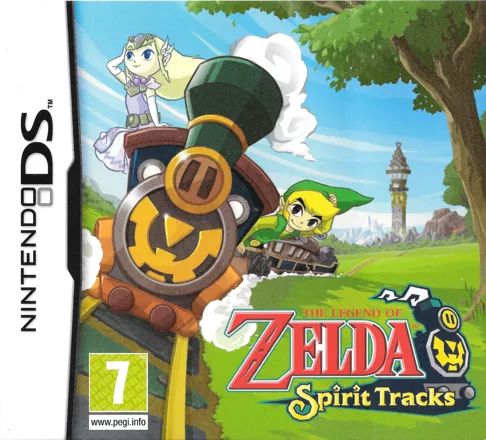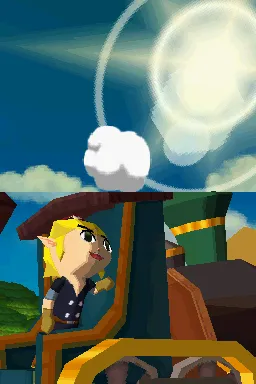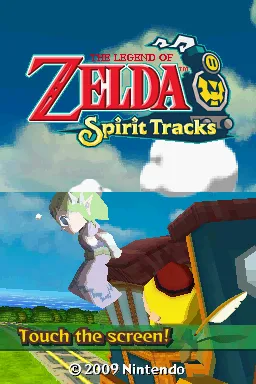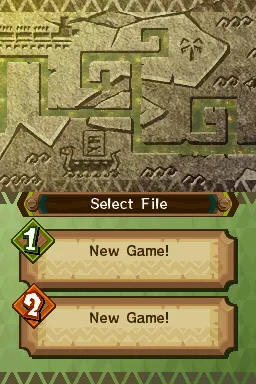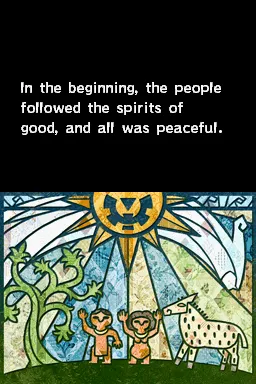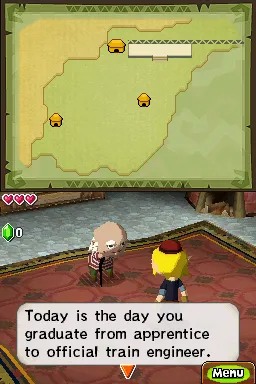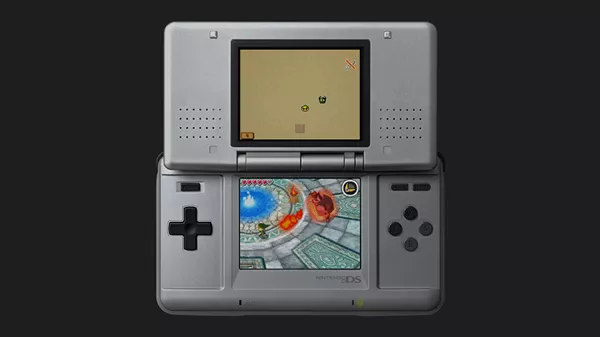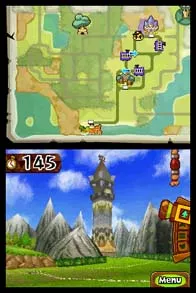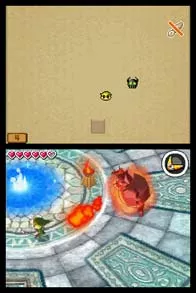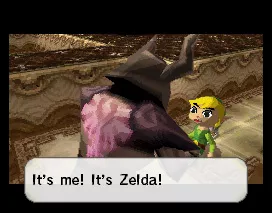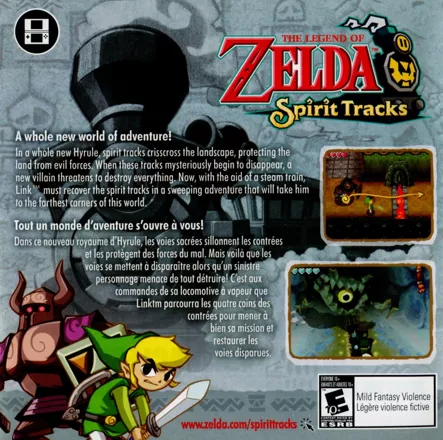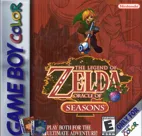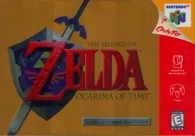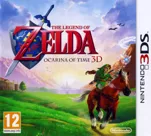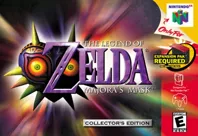The Legend of Zelda: Spirit Tracks
Description official description
Apprentice engineer, Link, is ready to travel to Hyrule Castle and receive his engineer's license - and meet Princess Zelda herself! However, during the ceremony, Zelda slips Link a note warning him not to trust the Chancellor, and to help her reach the Spirit Tower. The land's Spirit Tracks (mystical railway tracks that cover the land) have been disappearing, and she suspects that the Chancellor is the cause. While heading to the Tower, the Chancellor intercepts them, and proves Zelda's suspicions right - he casts a magic spell on her, splitting her body from her soul! Link and Zelda must work together to return Zelda to normal and save Hyrule once again.
In The Legend of Zelda: Spirit Tracks, the player takes on the role of Link. As with the previous game, Phantom Hourglass, players guide Link entirely with the stylus - using it to move him, target foes, and guide special weapons. The player is also encouraged to draw notes on the in-game maps - and in certain puzzles, it is crucial to do so. Link receives new tools in the game as he progresses, including a windmill, which is used to blow away debris, poison gas, and enemies, and the pan flute, which is used to activate special tunes that unlock new areas, discover secrets, and more. In certain dungeons, players will control both Link and Zelda, as they work together. In her spirit form, Zelda is able to possess hulking Phantom suits of armour, which can be used to block flames, protect Link, and carry him across dangerous areas.
As suggested by the title, the key method of transportation involves a train. Players draw their route to the next area on the map, and then let the train run its course. While the train is moving, they'll need to watch out for other trains, obstacles and animals on the tracks, and enemies. They'll also need to keep an eye on the best track route, which they can change as they near a junction.
Spellings
- ゼルダの伝説 大地の汽笛 - Japanese spelling
Groups +
Screenshots
Promos
Videos
Add Trailer or Gameplay Video +1 point
See any errors or missing info for this game?
You can submit a correction, contribute trivia, add to a game group, add a related site or alternate title.
Credits (Nintendo DS version)
156 People (139 developers, 17 thanks) · View all
| Director | |
| Planning | |
| Programming Lead | |
| Cinema Scene Programming | |
| Enemy Programming | |
| Object Programming | |
| Train Programming | |
| UI System Programming | |
| NPC Programming | |
| Wireless Programming | |
| Map Programming | |
| Phantom Programming | |
| Design Lead | |
| Player Design | |
| Enemy Design | |
| [ full credits ] | |
Reviews
Critics
Average score: 86% (based on 55 ratings)
Players
Average score: 3.8 out of 5 (based on 29 ratings with 2 reviews)
Not what I was looking for in a Zelda game
The Good
The graphics are fine. The game borrows from the same general aesthetic as Wind Waker and Phantom Hourglass before it. In fact, Zelda and Link look basically identical to their Wind Waker counterparts with Zelda wearing even the exact same outfit that she had in Wind Waker.
The overworld map was interesting with train routes magically appearing after completing a dungeon. I also enjoyed the visual of Link’s train chugging around the map. There were also some beautiful backdrops to behold while traveling around the world. Even though you are stuck on a train, most of the standard Zelda habitats are here: ocean areas, underwater areas, grassy areas and desert areas. The character and enemy designs are also well done for being on the DS.
The Bad
I was super stoked to try Spirit Tracks. The visuals, after all, were similar to Wind Waker, which is up there as far as one of my favorite Zelda games ever. Unfortunately, I just did not like this game.
The game originally released on the Nintendo DS and so the graphics are not stellar. There are a lot of pixelized and jagged edges. There's not as much depth and shadow effects as Wind Waker and the animations are not quite as fluid. I overall still enjoyed the visuals, but the flair that made Wind Waker such a joy to behold is basically missing from this entry into the series.
There was also a surprising lack of humor in this game. I recall laughing out loud at some of the slapstick humor in Wind Waker. Spirit Tracks has very little of this. Or, maybe due to the DS limitations, the humor just did not come across.
The requirement to use the stylus for EVERYTHING in the game was frustrating. Movement was not fun at all because I had to keep the pen on the screen to move.
I also believe that the use of the stylus makes this game a part of a completely different genre than other Zelda games: it’s basically a puzzle game. The Legend of Zelda is an action-adventure series with RPG elements. Because of the choices made in Spirit Tracks, I think it’s more of a puzzle game with light action-adventure elements. And that is the main reason I did not enjoy it. I have nothing against trying new things to add a fresh spin to something. However, I am not a huge puzzle game player. I don’t hate puzzle games, but I tend to gravitate toward games that have a story to tell, games that immerse the player into the character they are controlling. I was never immersed in Spirit Tracks. Everything felt like a puzzle, and this includes movement and combat.
The game is also literally on rails. To move around the map, Link must follow the rails on his train. I get that this is what the development team set out to accomplish but it really made me feel like I was limited in what I could do. After a certain point, Demon trains also appear to antagonize Link. These trains cannot be destroyed and a single tap from them means Link is dead and the game reloads. Not until the very end of the game is Link given the ability to destroy these trains. It was a very frustrating experience.
The Bottom Line
This is not a bad game, but it is a sub-par Zelda game, in my opinion.
I will praise the game for its music and the visuals.
If you like puzzlers, then this game may be fun for you. As for me, I will never have any interest in playing this game ever again.
Nintendo DS · by John Murphy (10) · 2022
The Good
Let's start by saying this game has a lot of similarities compared to the first Zelda outing on the DS; 2007's Phantom Hourglass. The same game engine and touch controls are here, the cell-shaded look from Phantom Hourglass and The Wind Waker is back as are many gameplay elements from that game and other Zelda games as well.
That's not to say Spirit Tracks doesn't do its best to feel new and fresh, on the contrary. It is another strong action-adventure outing in Nintendo's acclaimed series that, like the best games in the series, has some strong new elements that separate it from other Zelda titles. When Phantom Hourglass came out, I thought it was one of the best Zelda games in years because of its clever use of the Touch Screen. There were many puzzles based around touch screen mechanics in many highly original ways. I praised the game for incorporating the capabilities of Nintendo's handheld so well and in so many innovative ways into a 20-year old formula. At the time, I had no hesitation at all to say that this game was the all-round best game on the system.
So how does a game that plays, looks and feels so similar to a two-year old DS classic feel fresh and new. In Phantom Hourglass you had to sail a boat across a vast sea. That sea has been replaced with a more familiar Hyrule kingdom. Instead of sailing across the waves, there is now a vast network of train tracks, the titular Spirit Tracks, that protagonist Link has to traverse in his train. Controlling the train works very similar to the sailing in Phantom Hourglass. You plot your route on the map. However, you're also much more restricted because you are limited to the tracks. It may sound a bit boring but there are enough baddies and objects to keep it fun and engaging. You can blow your horn, blast your cannon at monsters and explore the far corners of Hyrule. The further you get in the main quest and the more side-quests you complete, the more tracks appear. Those tracks are an important part in this game's story.
It goes something like this: There once was a war between the ancient spirits of light and the demons and their king, Malladus. The spirits defeated and sealed Malladus away within the Tower of Spirits. The Spirit Tracks, which were used as shackles to keep the seal to his prison intact, are failing and disappearing. It's about a century after the events of Phantom Hourglass and nowadays, these tracks are used as train tracks. Link, our hero, having the important task of transporting princess Zelda as an engineer, gets stuck when the tracks simply disappear while he's using them. Malladus' followers steal Zelda's body to use it as a new body for Malladus' spirit, leaving Zelda's spirit behind. Together with Zelda's spirit, Link sets out to get Zelda's body back and stop Malladus and his nefarious helpers; Cole and Byrne who are bent on reviving Malladus' spirit. They are aided by the Lokomos, an ancient race of sages that link must seek out much like in Ocarina of Time. The Lokomos of the Tower of Spirits, Anjean, is your main mentor and she will tell you what to do and what regions of Hyrule you should visit next. With her help Link and Zelda travel all over Hyrule by train as a team, and a good one at that.
So instead of being the damsel in distress, Zelda is now your main sidekick, much like the fairy Ceila was in the previous game, for those who played it. This comes in handy in the Tower of Spirits. If you played Phantom Hourglass, you may remember the Temple of the Ocean King. This large dungeon had you finding your way through various floors while avoiding phantom knights bent on killing you. You had to visit this place multiple times throughout the game, beating more and more floors and finding new maps to travel to new areas.
The aforementioned Tower of Spirits is pretty much the same thing. However, this one is a vast improvement over its counterpart in the previous game. In that game, there was a time limit and you could not beat the phantoms until very late on in the game. In this game however, there is no time limit, and if you pick up three Tears of Light (back from Twilight Princess) you get the power to stab the phantoms in the back to stun them.
Zelda, being a ghost, can take them over and act as Link's help. With some good thinking and strong teamwork between the two, you can get through some seriously impressive puzzles, some of the best in the series, in fact. The overall dungeon is a bit more puzzle-based than the Temple of the Ocean King to make it fit more with a slower, more relaxed and all-round less frustrating pace.
Another major improvement is the fact that you don't have to do all or many of the previous floors again. There was only one half-way point in Phantom Hourglass and while you could speed up things with new items you didn't have at first, it was still very annoying. In Spirit Tracks however, you can skip all earlier sets of floors upon each subsequent visit. You can still revisit them, however, if you're a purist who wants to collect all treasures unavailable in an earlier run-through because you needed a specific item not yet obtained. In other words; revisiting floors is solely for replay value.
The land of Hyrule is divided into four regions with one or two temples in each of them. There is a forest area in which our heroes live, a snowy tundra, a mountainous area with volcanic activity and an ocean area with sea and sand. The temples reflect the nature of their surroundings. There is an underwater temple, a forest temple, a desert temple and more. Sound familiar? Yes, but the temples have enough new concepts to make them feel original. One of Phantom Hourglass' strongest points was the idea of scribbling hints or treasure locations on your map. That feature is back again, applied in ways both new and familiar, but always fun. There are some new items as well. I won't spoil too much, but a cool one to mention is a whip that turns Link into Hyrule's Indiana Jones. How cool is that? There are many cool puzzles, original enemies and just plain brilliant bosses to be tackled with these items inside the dungeons. There's a lot of diversity in them. At one point you're blowing spiky balls into a giant bug's face by blowing in the microphone, later on you're swinging with your whip from branch to branch or lighting a torch with your flaming boomerang to make a treasure chest appear. All in all, it is a balanced and solid mix of familiarities from earlier titles and new, original concepts.
Graphically it is very similar to Phantom Hourglass. The same cartoony style mostly associated with Wind Waker is still retained nicely on the small screen. The cell-shaded characters look fantastic and are not as low on polygons as in many other DS games. The environments are done in pretty 3D combined with the top-down perspective of classic Zelda games on systems such as the NES and SNES. While not as pretty as the towns and dungeons, the overworld is much more colorful and diverse than the slightly generic sea environments in Phantom Hourglass.
The controls are still as smooth as in the first game and only using the touch screen works fantastic. The issues with performing the roll move have been corrected in this game. It is amazing to see in how many ways the touch screen can be used. Just like in Phantom Hourglass, you will be amazed how much you can do with just a touch screen and a stylus if the proper time and attention is given by the proper development teams.
Sound and music are as strong as ever. Much like in Ocarina of Time, Majora's Mask and The Wind Waker, music is also a gameplay element in itself. While it does not play as big a role as in those games, it is still a very cool element in the game. This is because this game's musical instrument, the Spirit Flute, is played by blowing in the microphone. Not only is this fun, it also makes the gap between player and game smaller and makes you feel just that little bit more engaged with the game.
There is also multiplayer mode like in Phantom Hourglass. The winner is the one who collects the most gems. Trying to trap your friends is the trick and fun-factor here. When you're running across a seemingly ordinary floor, someone may trip a switch somewhere else in the room, opening the floor and dropping you in a dark pit. Simple but fun, and with some slight differences from Phantom Hourglass to keep it fresh.
The Bad
The biggest annoyance from Wind Waker, its pacing issues, were corrected in Phantom Hourglass. The sailing took less time and was less boring. However, its Spirit Tracks equivalent, the train travel, while not boring, does have the pacing issues Wind Waker had. The train idea is fun and clever, but it proves for a sluggish way of transport nonetheless. It's just a pain to get about, anyway. There are some warp points but they are not really helpful at all because they connect to only one specific point of the map. They should have made it so that you could select any other warp point on the map. I have no clue what they were thinking but it almost makes getting about the overworld more complicated instead of easier. The train itself moves slowly and all the travelling keeps the overall pace slow as if the developers wanted to conceal the short length of the game.
Short length? Yes, unfortunately, this game is even shorter than Phantom Hourglass, which I criticized for being too short and easy. Unfortunately, in Spirit Tracks nothing has been done to correct those issues. There is just five temples and the Tower of Spirits as a central hub dungeon. Too few, Nintendo! Some of the short length can be compensated by completing sidequests and collecting optional stuff but it still should have been a slightly longer experience. There are some clever puzzles in there that really tease your brain, but overall, it is not an overly hard game, either.
The overworld has some rough textures. It looks much less impressive than towns, dungeons etc.
The train tracks, while original and clever, take away a lot of the open-ended feel that Zelda is known for. While the world is vast and the network of Spirit Tracks grows bigger and bigger over the course of the game, Zelda fans may find that the game keeps you restricted too much. You just wish you could go out and explore those vast fields like you could in games like Ocarina of Time, Majora's Mask and Twilight Princess. It's not that it's bad, it may just be slightly disappointing for long-time fans.
While full touch screen controls worked perfectly, some people would have preferred an option to use buttons in Phantom Hourglass. Such an option is still not present. I wasn't annoyed by it one bit, but I know some people will be.
The multiplayer is not available for on-line play, only local wireless. This gets worse if you consider that Phantom Hourglass had on-line multiplayer. Why Nintendo? There is no excuse not to put an on-line mode in.
The Bottom Line
Overall, this is another Zelda masterpiece. It's not better than Phantom Hourglass but not worse either. For every shortcoming of its predecessor it corrects, it has something else that is inferior. All in all, both are about equal. If you have played Phantom Hourglass before, it may not be as fresh and innovative as that game as there are obvious similarities. However, when all is said and done, it's a game that packs enough charm and originality to warrant a purchase for all newcomers and long-time fans alike.
Nintendo DS · by Rensch (203) · 2009
Trivia
1001 Video Games
The Legend of Zelda: Spirit Tracks appears in the book 1001 Video Games You Must Play Before You Die by General Editor Tony Mott.
References
The rocket statues that teach Link new songs for his pan flute bear a striking resemblance to the rockets that you would sometimes find when pulling up a vegetable in Super Mario Bros. 2. After the song is taught, they even blast off in a similar manner!
Awards
- 1UP 2009 - Best DS Game
- Cheat Code Central
-
2009 - Nintendo DS Game of the Year
-
Game Informer
-
2009 - Best Handheld Game
-
GameShark
-
2009 - Nintendo DS Game of the Year
-
Gamespy
- 2009 - Nintendo DS Game of the Year
- 2009 - Nintendo DS Gamers' Choice Award
-
2009 - The Embarrassing Commute Award
-
IGN
- 2009 - DS Game of the Year
- 2009 - Best DS Action Game
- 2009 - Best DS Story
- 2009 - DS Award for Visual Excellence
-
2009 - DS Award for Excellence in Sound
-
Nintendo Power
- 2009 (Issue #252) - Nintendo DS Game of the Year
Information also contributed by Big John WV and Bob the Stickman
Analytics
Upgrade to MobyPro to view research rankings and price history! (when applicable)
Related Sites +
-
Nintendo.com
The Legend of Zelda: Spirit Tracks overview page at Nintendo's official site. -
The Legend of Zelda: Spirit Tracks
Official game web site by Nintendo of America.
Identifiers +
Contribute
Are you familiar with this game? Help document and preserve this entry in video game history! If your contribution is approved, you will earn points and be credited as a contributor.
Contributors to this Entry
Game added by Ben K.
Wii U added by Michael Cassidy.
Additional contributors: Patrick Bregger, sgtcook, FatherJack.
Game added December 12, 2009. Last modified January 28, 2025.


